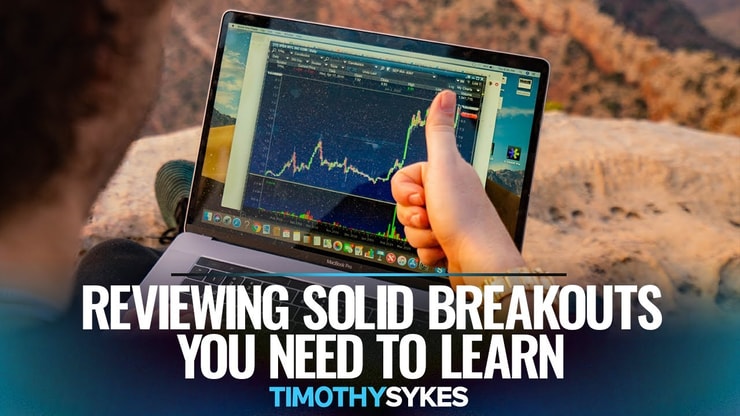The triple bottom pattern is a strategy used by traders to capitalize on bullish momentum. It involves monitoring price action to find a distinct pattern before the price launches higher. The “triple bottom” name comes from the chart’s shape before the price spikes.
Recognizing the pattern in the wild and successfully trading it … that’s easier said than done.
But that’s why I’m here.
I have over two decades of trading experience.
And in that time I’ve shown my trading process to countless individuals.
I’ve even helped over 30 students reach the $1 million milestone … some people ask why that number isn’t higher. “Why isn’t everyone successful with your process?”
It’s simple, people fail for two main reasons …
- Trading isn’t for everyone
- The best things in life don’t come easy
The triple bottom pattern is an effective strategy. But it takes the right kind of person to use it successfully.
If you’re interested in trading, that’s a great start.
And take from me, it’s not rocket science. If I can do this, so can you.
All it takes is some persistence and elbow grease.
Let’s get to the nuts and bolts of this strategy …
Table of Contents
- 1 What is a Triple Bottom Pattern?
- 2 How to Identify a Triple Bottom?
- 3 The Significance and Limitations of the Triple Bottom Pattern
- 4 How to Trade a Triple Bottom Pattern
- 5 Examples and Case Studies
- 6 Advanced Triple Bottom Pattern Trading Techniques
- 7 Key Takeaways
- 8 Frequently Asked Questions (FAQs)
- 8.1 Can Triple Bottoms Fail?
- 8.2 What Is the Opposite of Triple Bottom?
- 8.3 Is a Double Bottom Better Than a Triple Bottom?
- 8.4 How Does Understanding Price Action Contribute to the Interpretation of Highs, Indicators, Momentum, and Market Data?
- 8.5 How Do Brokers, Rates, Buyers, Sellers, and the Direction of Trades Interact in the Marketplace?
- 8.6 How Can Trading Strategies, Stop Losses, and Performance Knowledge Help in Managing My Assets and Pace in Trading?
- 8.7 As a Beginner, How Can Articles, Guides, and Educational Tools Help Me in Understanding Trading Strategies and Managing My Trading Account?
- 8.8 How Does Knowledge of Candle Patterns, Trend Direction, and Breakout Points Influence the Trading Strategy and Its Results?
- 8.9 What Are Some Key Insights Into the Services Provided by Brokers, the Role of Partnerships, and the Influence of Company Policies on Trading?
- 8.10 How Does the Concept of ‘Work’ in Trading Relate to Elements Like Trading Strategies, the Use of Tools, and Education?
- 8.11 How Does Understanding the Likelihood of Certain Market Events Influence Trading Decisions?
- 8.12 How Does the Concept of a ‘Neckline’ Apply to Trading, and How Does It Affect My Trading Strategy?
- 8.13 How Do Elements Like Risk, Pressure, Pace, and Performance Interact in the World of Trading?
- 8.14 How Does Research and Analysis Factor Into Successful Price Action Trading?
- 8.15 How Do Beginners Start With Price Action Trading, and What Resources Are Available to Them?
- 8.16 How Do Trading Sessions and Calendars Factor Into Price Action Trading?
- 8.17 How Do Trading Risks and Failures Contribute to a Trader’s Development in Price Action Trading?
- 8.18 How Does Investment Advice and Opinions Factor Into Price Action Trading?
What is a Triple Bottom Pattern?
A Triple Bottom Pattern is a specific chart formation that becomes apparent when a security’s price tests the support level three times, each time bouncing back without breaking through.
Think of it as a heavyweight boxer trying to punch through a wall, the third punch is the charm.
This pattern is often seen as a bullish reversal pattern and could signal a coming uptrend in the market.
How to Identify a Triple Bottom?

Recognizing a Triple Bottom Pattern is an art, just like any other chart pattern. Price action analysis is a skill traders develop over time.
There are a few factors to keep in mind …
First, it starts with up-to-date data.
A lot of people don’t know this … free trading software usually displays price data 10 – 20 minutes late.
Trading volatile stocks with late data is like signing a death wish.
I use StocksToTrade because it’s designed specifically for small-account traders that capitalize on highly volatile price swings. I even helped build it to make sure it fits our needs.
Here’s a 14-day trial of StocksToTrade for just $7.
When it comes to a triple bottom, the three distinct lows or “bottoms” of similar price levels are your first clue. These bottoms are separated by two peaks, creating a resistance level that the price struggles to break through.
Keep an eye out for an increase in volume during the rise following the third bottom – this may signal a bullish trend on the horizon.
The bottom formation often leads to an upward spike.
What Happens After the Triple Bottom Pattern?
Once the Triple Bottom Pattern forms, there’s often a significant price movement to the upside, also known as the breakout.
I included some other breakout examples below …
This typically occurs when the price moves above the resistance level that tops the three bottoms. This breakout is your signal to enter a long trade.
What Happens with a Failed Triple Bottom Pattern?
But let’s face it, not every Triple Bottom Pattern leads to a breakout.
Sometimes, the pattern fails, and the price breaks down below the support level instead of breaking out above the resistance.
In this case, it’s crucial to have a stop-loss in place to limit potential losses.
The Significance and Limitations of the Triple Bottom Pattern

Like any other trading tool, the Triple Bottom Pattern has its strengths and limitations.
Understanding these can make the difference between a successful trade and a not-so-successful one.
Let’s go through everything …
More Breaking News
- Broadcom’s 20% Surge: Analyzing the AI Boom and Market Impact
- Quantum Leaps: The Future of Storage Revealed with New Myriad System
- Tesla Stock Soars with New Predictions: Is a Game-Changer on the Horizon?
The Triple Bottom Pattern: Pros and Cons
On the upside, the Triple Bottom Pattern is a reliable tool for predicting a bullish reversal, giving price action traders a chance to get in on the uptrend early.
However, it can also be a double-edged sword. If misidentified or if the pattern fails, it can lead to losses. So always trade with caution and never risk more than you can afford to lose.
It takes the right set of skills to trade successfully.
How Reliable Is a Triple Bottom Pattern?
No pattern is foolproof, and the Triple Bottom Pattern is no exception.
While it can be a strong indicator of a potential bullish reversal, its reliability greatly depends on proper identification and market conditions.
Just like in any form of trading, there’s no guarantee of profits, only the probability of outcomes.
How to Trade a Triple Bottom Pattern
Trading a Triple Bottom Pattern requires a keen eye, a cool head, and a solid understanding of the pattern’s structure.
And remember, it’s not the only pattern out there. If you’re having trouble trading, maybe you need to focus on a new strategy.
Another popular pattern is called the first-green-day strategy. I included a tutorial below …
Triple Bottom Entry and Exit Points
The breakout above the resistance level offers a strategic entry point for traders.
As for the exit point, it’s common to set a price target that’s the same distance as the height of the pattern.
And remember, setting a stop-loss is non-negotiable. It’s your safety net in case the trade doesn’t go as planned.
Examples and Case Studies
What better way to understand the Triple Bottom Pattern than by delving into some practical examples?
Let’s look at how this pattern plays out in stocks, crypto, and forex trading.
Stock Triple Bottom Example
Let’s imagine a stock that’s been in a prolonged downtrend.
Suddenly, it hits a low point, rallies up to a peak, and then descends to the same low point again, twice. This forms a Triple Bottom Pattern.
If the stock price breaks out above the peak levels, it could be a great opportunity to go long on the stock.
That break out could signal a trendline reversal.
This pattern can develop intraday and over a series of days. But swing trading isn’t my specialty so you’ll likely only see me trade intraday.
Triple Bottom Pattern Example in Crypto Trading
Even in the volatile crypto markets, the Triple Bottom Pattern holds its ground.
For instance, if Bitcoin hits a low three times and fails to drop further, we could be looking at a Triple Bottom Pattern.
A subsequent breakout above the resistance could signal the start of a new bullish trend.
Forex Triple Bottom Example
Forex markets are ripe with opportunities for Triple Bottom Patterns.
Let’s say the USD/EUR pair hits a specific low point three times without breaking down further. If it then breaks out above the resistance level, it could be an excellent opportunity to buy the pair.
Advanced Triple Bottom Pattern Trading Techniques

Feeling comfortable with the basics? Great. Let’s step up your game with some advanced trading techniques.
Advanced trading techniques often involve the use of various indicators.
One such indicator that can complement your understanding of the Triple Bottom Pattern is the Fibonacci retracement. This tool can help identify potential areas of support and resistance, enhancing your trading strategy.
If you’re keen to learn more about this tool, here’s an in-depth article on Fibonacci retracement.
Moving Average Convergence Divergence (MACD) and Triple Bottom Chart Patterns
When used in combination with the MACD indicator, the Triple Bottom Pattern can be even more powerful.
For instance, a bullish MACD crossover at the same time as a Triple Bottom breakout could be a strong buy signal. The MACD gives us important averages that strengthen consolidation patterns like the triple bottom.
While MACD is a powerful tool, it’s not the only indicator that can enhance your trading strategy. The Average True Range (ATR) is another valuable indicator that measures market volatility.
By understanding how ATR works, you can better manage your risk and identify potential trading opportunities. If you’re interested in learning more about this indicator, check out this comprehensive guide on the Average True Range.
Fibonacci Retracement Levels and Triple Bottom Chart Patterns
Fibonacci Retracement levels can be used in conjunction with the Triple Bottom Pattern to pinpoint potential support and resistance levels.
If a breakout occurs at a key Fibonacci level, it could enhance the reliability of the buy signal.
Fibonacci retracement levels can provide key insights into potential support and resistance levels.
However, to fully leverage these insights, it’s crucial to understand other trading indicators as well. One such indicator is the MACD, which can help identify potential buy and sell signals.
To deepen your understanding of how to use this indicator, consider reading this detailed post on how to use the MACD indicator.
Key Takeaways
Here’s the deal: The Triple Bottom Pattern is a useful tool in a trader’s arsenal, helping to predict potential bullish reversals.
But it’s not a magic wand. Always use other forms of technical analysis to confirm signals and, above all, manage your risk wisely.
Trading isn’t rocket science. It’s a skill you build and work on like any other. Trading has changed my life, and I think this way of life should be open to more people…
I’ve built my Trading Challenge to pass on the things I had to learn for myself. It’s the kind of community that I wish I had when I was starting.
We don’t accept everyone. If you’re up for the challenge — I want to hear from you.
Apply to the Trading Challenge here.
Trading is a battlefield. The more knowledge you have, the better prepared you’ll be.
Do you use diamond pattern trading in your trading strategy? Let me know in the comments — I love hearing from my readers!
Frequently Asked Questions (FAQs)

So you’ve got questions? Good. Let’s answer some of the most common queries about the Triple Bottom Pattern.
Can Triple Bottoms Fail?
Indeed, they can.
A Triple Bottom Pattern can fail if the price breaks down below the support level rather than breaking out above the resistance.
That’s why it’s critical to always set a stop-loss.
And remind your buddy to set a stop loss. We’ve got to watch out for each other.
What Is the Opposite of Triple Bottom?
The opposite of a Triple Bottom is a Triple Top, a bearish reversal pattern that signals a potential change from an uptrend to a downtrend.
The triple top is a pattern for short sellers.
Is a Double Bottom Better Than a Triple Bottom?
Not necessarily.
Both price action patterns signal potential bullish reversals, but the Triple Bottom has an added layer of confirmation because the support level has been tested one more time.
However, neither pattern guarantees profits, and both should be used in conjunction with other forms of technical analysis.
That goes for all price action strategies.
How Does Understanding Price Action Contribute to the Interpretation of Highs, Indicators, Momentum, and Market Data?
Understanding price action is crucial to the interpretation of highs, indicators, momentum, and market data. After all, this is a price action strategy.
By analyzing the movement of prices over time, traders can identify trends, anticipate potential future price movements, and make more informed trading decisions.
This includes understanding how price action reflects the market’s momentum and how it forms the highs and lows observed on the charts.
It can also inform the use of various technical indicators, contributing to a more comprehensive trading strategy.
How Do Brokers, Rates, Buyers, Sellers, and the Direction of Trades Interact in the Marketplace?
In the marketplace, brokers facilitate transactions between buyers and sellers, often determining the rates for these trades.
The direction of trades, whether buying or selling, influences market dynamics and ultimately the price of assets.
Market news can affect buyer and seller behavior, causing fluctuations in trade direction and asset prices. Understanding these interactions is vital for successful trading.
How Can Trading Strategies, Stop Losses, and Performance Knowledge Help in Managing My Assets and Pace in Trading?
Trading strategies, including the use of stop losses, play a key role in managing assets and determining the pace of trading.
A well-planned strategy can help to protect your assets, regulate your trading pace, and optimize your overall trading performance.
Stop losses are a crucial risk management tool, potentially preventing substantial losses in volatile markets. Also, ongoing education and staying informed about market trends can help to refine these strategies over time.
As a Beginner, How Can Articles, Guides, and Educational Tools Help Me in Understanding Trading Strategies and Managing My Trading Account?
As a beginner, articles, guides, and educational tools provide valuable information for understanding trading strategies and managing your trading account.
Also, make sure to look at a price action chart at least once a day. There are different types but candlestick charts are preferred by most traders. Candlesticks show us a lot of data with a simple approach.
These resources can help you learn the basics of trading, familiarize yourself with various trading strategies, understand the importance of risk management, and guide you in setting up and managing your trading account.
How Does Knowledge of Candle Patterns, Trend Direction, and Breakout Points Influence the Trading Strategy and Its Results?
Knowledge of candle patterns, trend direction, and breakout points significantly influences the formation and execution of trading strategies and their results.
Candle patterns can give insights into market sentiment while understanding trend direction can help identify potential profitable trades. Identifying breakout points can provide lucrative trading opportunities.
By incorporating these elements into a trading strategy, traders can potentially enhance their trading results.
What Are Some Key Insights Into the Services Provided by Brokers, the Role of Partnerships, and the Influence of Company Policies on Trading?
Brokers’ services are vital in facilitating trades, providing market access, and sometimes offering educational resources for traders.
Partnerships between companies in the financial sector can affect market dynamics, influencing trading opportunities.
Company policies, especially those of your broker, can impact your trading conditions, such as fees and order execution, so understanding these is crucial for effective trading.
How Does the Concept of ‘Work’ in Trading Relate to Elements Like Trading Strategies, the Use of Tools, and Education?
‘Work’ in trading refers to the consistent effort traders put into learning about market trends, refining their trading strategies, using various trading tools effectively, and continuously updating their education.
This concept highlights the dynamic and ongoing nature of trading, requiring a commitment to learning and adaptation for sustained success.
How Does Understanding the Likelihood of Certain Market Events Influence Trading Decisions?
Understanding the likelihood of specific market events can significantly impact trading decisions.
Traders use statistical analysis, historical data, and current market trends to predict the probability of these events, helping them position themselves for potential market movements.
This can be particularly relevant when trading volatile assets or during significant economic announcements.
How Does the Concept of a ‘Neckline’ Apply to Trading, and How Does It Affect My Trading Strategy?
In trading, the ‘neckline’ refers to a level of support or resistance in chart patterns, such as head and shoulders or double bottom patterns.
The neckline’s break can indicate a potential reversal in price trend, providing a signal to enter or exit a trade.
Understanding and accurately identifying the neckline can enhance the effectiveness of your trading strategy.
How Do Elements Like Risk, Pressure, Pace, and Performance Interact in the World of Trading?
Risk, pressure, pace, and performance are intertwined in trading.
The pace of trading can influence the level of pressure a trader experiences, which can, in turn, impact their performance.
Managing risk effectively can help control the pressure and maintain a sustainable trading pace, ultimately influencing trading performance positively.
It’s essential to find a balance between these elements to trade successfully.
How Does Research and Analysis Factor Into Successful Price Action Trading?
Successful price action trading heavily relies on in-depth research and analysis.
Traders must examine charts, identify patterns, understand trends, and stay updated with market news.
Analysts and investors utilize different tools and indicators to analyze the price and volume data of a trading session, leading to informed trading decisions.
How Do Beginners Start With Price Action Trading, and What Resources Are Available to Them?
Beginners can start with price action trading by educating themselves on the basics.
Various resources, such as courses, content-rich articles, tips, and reviews, are available for understanding the principles of price action trading.
Engaging with a support team or community can provide real-time assistance and practical advice.
How Do Trading Sessions and Calendars Factor Into Price Action Trading?
Trading sessions and calendars play a vital role in price action trading.
Traders must be aware of different trading sessions and their impact on market volatility.
Additionally, a financial calendar can provide crucial information about upcoming economic events that could influence market trends and price action.
How Do Trading Risks and Failures Contribute to a Trader’s Development in Price Action Trading?
Understanding and managing trading risks is a significant part of a trader’s journey in price action trading.
Every trader experiences failures, but these instances can serve as valuable lessons. Analyzing these failures helps in identifying mistakes and improving future strategies.
How Does Investment Advice and Opinions Factor Into Price Action Trading?
Investment advice and opinions can provide insights into potential market movements and trading strategies.
However, traders should use these as guiding tools rather than definitive instructions.
It’s important to understand that everyone’s trading style, risk tolerance, and investment goals are unique. Thus, traders should combine advice and opinions with their research and analysis to make trading decisions.




Leave a reply